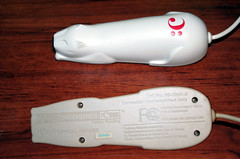Do CueCats Have 9 Lives?!? Google Resurrects a Bad Idea
For those of us who’ve been around the internet biz for a while, there’s often a feeling of deja vu or “been there, done that!” Thus we have that sensation today when we see this article from Silicon Alley Insider which seems to gush just a bit in its praise of these cute, “new” barcodes that Google is resurrecting in some print ads that can be scanned camera phones so people can easily connect up instantaneously to associated websites.
The article fails to mention the last time this sad concept was foisted on the world. Remember the company, Digital Convergence, with their various “CueCat” devices that allowed people to do this exact same thing?
The CueCat was developed in the earlier days of the internet, way back in the dot-com craze, and it was one of the bigger dot-bombs, sucking air and falling flat almost before any of the other dot-combs bit the dust. As recently as 2006, the Wall Street Journal called the CueCat one of the worst gizmos and bad business ideas of the internet.
Of course, I might be a bit full of hubris myself if I didn’t acknowledge that sometimes it takes a few trials and errors to make an idea commercially viable. Perhaps having this functionality usable from a cellphone makes it easier to adopt, and Google is certainly one company that might be able to make something work if no one else could. Silicon Alley Insider notes that this is apparently popular in Japan, but one still can’t escape the sensation that there’s perhaps some hype machine pushing up the appearance of relative popularity, similar to the defunct version of the idea that previously was foisted upon hypnotized investors here in the states.
The question remains: as a consumer, why would I want to scan (or snap a pic of) a barcode in a news ad I’m reading to be transported on my wireless device to the website? Is a wireless device really going to show me more info than a print ad could?!? The circumstances where I’d be interested in doing this are extremely rare, I’d suspect. This new incarnation may have lower hassle factor involved than the CueCat, but the issues are still essentially the same from my perspective. Bad idea.
My old company experimented with the CueCat product way back then, and I was immediately astonished that anyone thought this would be a good or viable idea for print ads — I recall being dumbfounded in the very first meeting I was pulled into in order to begin integrating with the thing, while others around me seemed to’ve drunk the Koolaid. Within a year or two, the Digital Convergence company began circling the drain as it was destined to do, and I was called in to vet their tech and internet assets for possible acquisition at a discount.
When the Digital Convergence company went belly-up, taking with it investment dollars from a great many individuals and major corporations, the stink was so bad that the founder, J. Jovan Philyaw, changed his name to J. Hutton Pulitzer and his personal website was launched with the company and product name pretty thoroughly sanitized from it.
I’m surprised the Silicon Alley Insider doesn’t remember this whole sequence and how stunningly bad the barcode concept was, but perhaps it didn’t make as much impression on Silly Valley, since Digital Convergence was a Dallas company.
Possible Related Posts
Posted by Chris of Silvery on 01/29/2008
Permalink | |  Print
| Trackback | Comments Off on Do CueCats Have 9 Lives?!? Google Resurrects a Bad Idea | Comments RSS
Print
| Trackback | Comments Off on Do CueCats Have 9 Lives?!? Google Resurrects a Bad Idea | Comments RSS
Filed under: Advertising, Google, technology CueCat, Digital Convergence, Google, Google Adwords



No comments for Do CueCats Have 9 Lives?!? Google Resurrects a Bad Idea
No comments yet.
Sorry, the comment form is closed at this time.